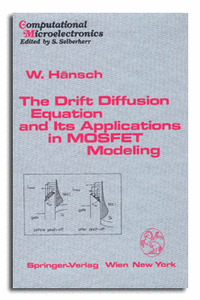Book Information

The Drift Diffusion Equation and Its Applications in MOSFET Modeling
- Author: Hänsch, Wilfried
- Published: 1991, 271 pages, 95 figures
- ISBN: 978-3-7091-9097-5 (Hardcover), 978-3-7091-9095-1 (eBook)
- Information from Amazon
Abstract:
Computational Microelectronics ISSN 0179-0307 The drift diffusion equation has proved to be very powerful to describe charge transport in devices even with feature sizes entering the deep submicron region. It allows, in a very natural way, the unification of the important physical phenomena and the complex geometries into a mathematical code. The physics is phenomenologically described and it is of considerable interest to find its underlying microscopic description. The Drift Diffusion Equation and Its Applications in MOSFET Modeling will bridge this gap between phenomenological modeling and a rigorous microscopic approach. It focusses primarily on MOSFET related features. The book is organized in five chapters which cover the rigorous derivation of the Boltzmann equation from non-equilibrium quantum mechanics in Chapter I to a semi-empirical formulation of MOSFET degradation in Chapter V. It aims for a physical understanding of successfully used concepts in modeling. For instance a detailed account of the bulk and surface mobility in an electron phonon impurity system is given. In Chapter II the implications of the relaxation time approximation are discussed in very detail and the hydrodynamic equations for the case of strong nonequilibrium are developed. Especially the problem of a self-consistent closure and how velocity overshoot can be included in an extended drift diffusion equation is addressed. In Chapter IV analytical approaches to determine the high energy distribution of carriers in high electric fields are treated. The result of this chapter is a self-consistent formulation of impact ionisation and oxide injection which serves as an important input for Chapter V where we study the spatial and temporal built up of charges in the gate oxide of a MOSFET device under electrical stress. The book invites physicists to the realm of modeling and offers members of the modeling community the possibility to get acquainted with the theoretical concepts of carrier transport.
